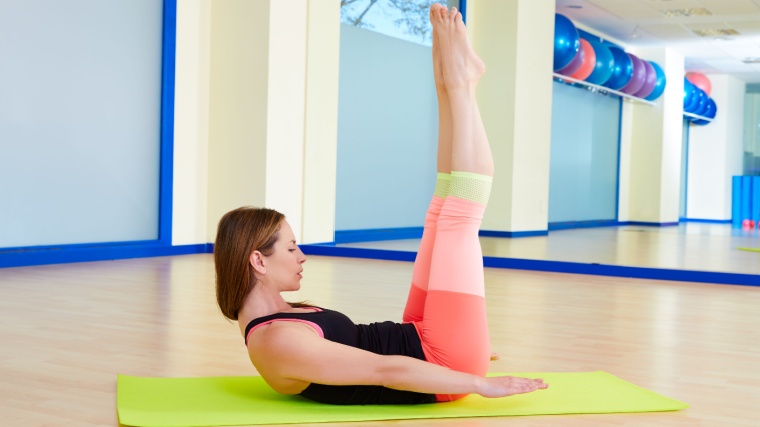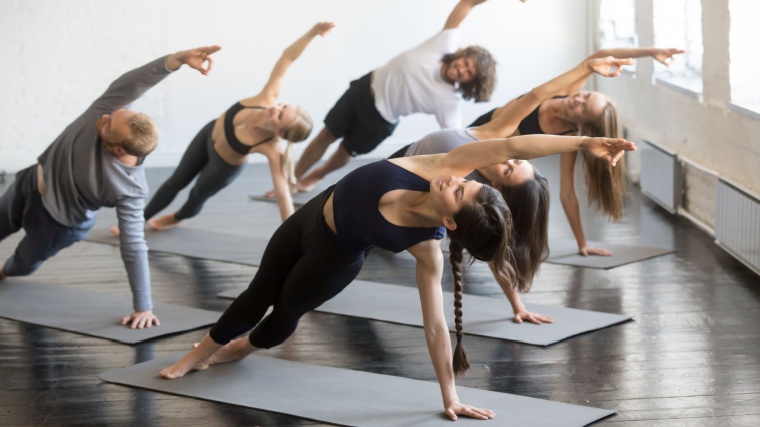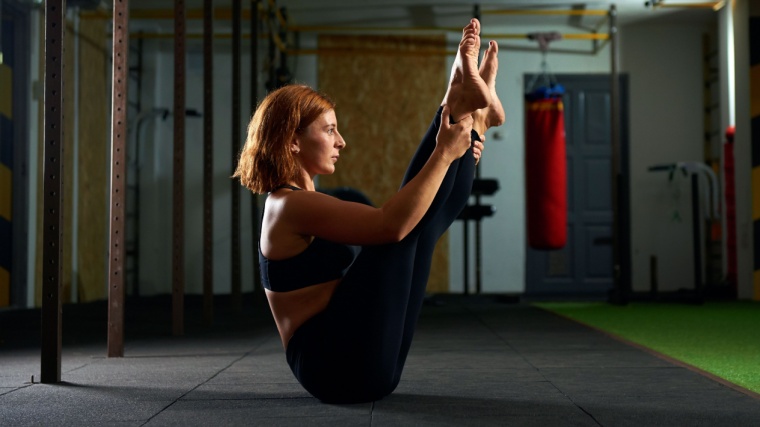After this year’s Grammy Awards, Miley Cyrus’s lean, muscular physique took the country by storm. Everyone wanted to know what the secret was to getting her rockstar arms. The answer: Pilates.
To help you figure out whether it’s worth it to make Pilates part of your training routine, I sat down with Pilates instructor Abby Middleton. She’ll give you a solid understanding of what makes Pilates such an effective workout style. Aside from sleek, strong arms, we discussed many other benefits of adding Pilates to your workout routine.
Note: Everyone’s body is different and many factors impact what your body looks like. Even if you do the exact workout and eat the same as Miley, your body will look its own way.
What Is Pilates?
Pilates is a low-impact workout method that focuses on strength, balance, and flexibility. It was developed by Joseph Pilates in the early 20th century during his incarceration in an internment camp. He drew from his surroundings, including the metal coils on hospital beds — think of modern-day Pilates reformers. His goal was to strengthen the body and the mind in the midst of injury and illness (1)
Today, Pilates is a catch-all for a full-body workout style that places extra emphasis on working your entire core, often while lengthening through your limbs. The classic Pilates workout typically consists of a series of 34 different, simple Pilates moves that can be scaled to any fitness level.

[Read More: Larry Wheels Learns How Challenging Pilates Can Be]
The same exercises that can provide a vigorous, challenging workout for a seasoned athlete can also be modified to gentle strength training to aid rehabilitation or support beginners. It’s also a low-impact workout that’s easy on the joints, making it a great workout for older adults, too. Overall, Pilates is a versatile workout style that is perfect for building core strength and improving posture.
Pilates Principles
There are six guiding principles of Pilates:
- Centering
- Concentration
- Control
- Precision
- Flow
- Breath
Centering and concentration involve bringing your mind into the present and letting your mind focus on the workout in front of you.
Control and precision refer to the exactness with which each rep is performed and done so by engaging your muscles and moving with perfect, meticulous form.
Flow is the grace with which Pilates is performed. There are no dropping weights, no jerky movements, and no using force in Pilates.
The final principle, breath, is connected to each rep, helping you stay present and get the most out of each exercise.
Getting the most out of Pilates lies in bringing all of these principles together in one workout.
Breathing in Pilates
Breath control is an essential aspect of Pilates.
Pilates cannot be done without the breath in mind.
— Abby Middleton
“Pilates breathing is all about the abdominals,” Middleton explains. “The abs are active and the main expansion happens in the ribs: lateral breathing. With each exhale you engage the abs more and you try to resist the inhale by keeping the abdominals active.”
Breathing this way during Pilates makes it easier to engage your core muscles and results in a more effective workout.
[Read More: The Best Ab Exercises, Plus Ab Workout Routines]
Pilates is often performed in a group fitness setting. You can find many boutique gyms that offer Pilates classes and exercise programs where a certified Pilates instructor guides you through a workout. It is also possible to work out on your own. For best results, it is often recommended to perform a one-hour session twice per week.
If local Pilates classes aren’t accessible to you, a lot of qualified instructors host programming online that you can follow along to from the privacy of your own home.
Pilates Vs. Yoga
While Pilates and yoga are both popular workouts for promoting body awareness, flexibility, strength, and overall well-being, there are a few key differences that set Pilates apart.
Similarities
- Mind, Body, and Spirit Practice: Both practices emphasize a mind-body connection that promotes mental clarity, focus, and relaxation, which adds a mental benefit to the workout.
- Body Awareness: Creating awareness and being conscious of how your body moves through a given space is important for both.
- Improve Flexibility: The two support increased flexibility through stretching and lengthening your muscles, allowing your body to move through a full range of motion.
- Improve Posture: Both include movements that can support the spine and strengthen the core which promotes good posture, possibly alleviating low back pain.
- Focus on Breath: Both practices emphasize proper breathing techniques to enhance oxygen flow, improve concentration, and reduce stress.
- Low-Impact: Both practices are low-impact, meaning they aren’t hard on the joints and don’t put as much stress on your body as much as other forms of exercise like running or Olympic lifting. This means it can be more accessible to people of all ages and fitness levels.
- Full Body Workout: Pilates and yoga incorporate the whole body allowing all muscle groups to be worked.
- Equipment Is Optional: You can get a great workout using your body weight with both Pilates and yoga, but both also can incorporate various props or machines (e.g., yoga blocks, straps, Pilates reformer) to enhance or modify exercises.
- Largely Accessible: Both can be great workouts for all levels and ages. Whether you are a powerlifter, an older adult just coming back to working out, or even recovery post-surgery, you may be able to benefit from both yoga and Pilates.
[Read More: Exercises to Strengthen the Lower Back & Prevent Pain, Plus Workouts]
Differences
- Origin and Intention: While Pilates originated in the early 20th century by Joseph Pilates, yoga can be traced back much further to ancient India and has a holistic approach that melds spiritual and physical health — it encompasses more than just the movements and workouts.
- Structure: Pilates has a more structured and systematic approach to exercise. It usually involves performing exercises for a high number of reps, whereas yoga can be more free-flowing and does not involve a set/rep scheme at all. Having said that, in both, you can hold a position in isolation for a given time.
- Core Activation: Though yoga can and does improve core strength, Pilates focuses heavily on the core and offers more of an explicit core strengthening and endurance workout.
- Toning and Muscle Building: While yoga may result in toning and building muscle, it is not a primary focus like in Pilates, which has been shown to build lean muscle.
[Read More: The Best Back Exercises And Full Workouts To Build Muscle And Strength]
Types of Pilates
Following its inception in the early 1920s, Pilates has evolved into many different variations, each style offering unique benefits.
When I asked Middleton about the types of Pilates she explained, “[There are] more than I know! The two big categories are ‘Classical’ and ‘Contemporary.’ …The Classical Pilates Studios really stick to the original exercises, orders, and equipment developed by Joseph Pilates and passed down by his proteges…Contemporary is everything else.”

[Read More: The Best Online Personal Trainers]
In other words, “contemporary” approaches to Pilates are those creative workouts you might check out on YouTube or your local community center or gym. However, Middleton points out that, “Anyone can teach Pilates as there is no trademark…and very little required regulation. Your Pilates group class at the gym may not be authentic Pilates.”
While there are a variety of different Pilates methods, the goals of core strength and flexibility, as well as the six principles are maintained at the core of each. Selecting the perfect style for you depends on your goals and access to Pilates equipment.
- Classical Pilates: This is the closest form of Pilates to Joseph Pilates’ original methods. It combines mat exercises with machine exercises.
- Mat Pilates: This is perhaps the most accessible form of Pilates because it can be done using only a mat and body weight. You can also use other Pilates equipment like magic circles (a rubber circle with handles on opposite sides), light weights, and therabands to support the workout.
- Reformer Pilates: Reformer Pilates uses a machine called a reformer composed of a platform and a pulley system made of springs and straps. You stand on the platform, called the carriage, and adjust the springs to add more or take away resistance as needed. This style uses more balance as you are standing on top of the platform that slides back and forth throughout the workout.
- Clinical Pilates: As the name suggests, clinical Pilates is used in rehab settings. This is usually a one-on-one session with a physical therapist and focuses on the specific needs of the patient following surgery or injury.
Benefits of Pilates
Pilates can be a key that unlocks a lean, muscular physique, but there are lots of other benefits, too. While it is often marketed toward women, it has been shown to benefit people of all genders.
Increases Muscular Endurance and Flexibility
Pilates exercises help build muscle in the entire body and improve muscle strength. Regular Pilates practice emphasizes the stretching and lengthening of muscles, which can increase flexibility, reduce muscle tension, and enhance range of motion. Research suggests that after 12 weeks of two 60-minute Pilates sessions per week, subjects saw significant increases in abdominal endurance, hamstring flexibility, and upper-body muscular endurance. (2)
Strengthens the Core
Pilates workouts place heavy emphasis on building strong abdominal muscles. Your core consists of many layers from the rectus abdominous (your exterior “six-pack” muscles) and obliques to the transverse abdominous, the deepest layer that wraps around your spine.
[Read More: The Best Bodyweight Exercises, + Workouts and Tips From a CPT]
A 2021 study showed that participants who practiced Pilates regularly had better core engagement than those who did not practice Pilates. (3) Having a strong core may also help relieve lower back pain and help lengthen your posture.
Improves Posture and Body Alignment
Performing Pilates regularly strengthens your postural muscles, specifically your spine, core, and low back, helping you sit taller. (3) This promotes increased body alignment and supports movement patterns that are associated with spinal health, reduced back pain, and decreased risk of injuries.
Alleviates Low Back Pain
Mitigating low back pain is a by-product of having a strong core and proper posture. Through strengthening the core muscles and working on your posture, your lower back takes on less stress and will be better supported.
Increases Oxygen Uptake
While you won’t want to completely replace your weekly jog with your Pilates class, there is some evidence that Pilates can help improve your cardiovascular health. In a study that compared Pilates to walking, Pilates was found to be better for improving oxygen uptake at the ventilatory threshold and the respiratory compensation point. (4)
In a nutshell, the moment at which the participants started to breathe faster during physical activity was increased. Unfortunately, the study did not say what the speed at which the walking group was moving, so it is hard to indicate how intense the walking was.

[Read More: The Best Online Workout Programs For Coaching, Cardio, Value, And More]
Regardless of your choice of exercise, to improve your cardiovascular health, you must raise your heart rate during your workout. If Pilates helps you do that, it may be a helpful addition to your heart-health routine.
Assists in Rehabilitation
Pilates is a low-impact routine that significantly strengthens areas of your body that may otherwise be neglected. Research suggests that Pilates may be able to help alleviate pain specifically from ankylosing spondylitis (an inflammatory disease affecting the spine), multiple sclerosis (a chronic disease of the central nervous system), post-menopausal osteoporosis (low bone mass in post-menstruation individuals), non-structural scoliosis (a curvature in the spine), hypertension (high blood pressure), and chronic neck pain. (5)
Strengthens Pelvic Floor
The pelvic floor is made up of the muscles at the bottom of the pelvis that support the bladder and bowel, as well as the uterus for people who have uteruses. Urinary incontinence is a common issue of a weak pelvic floor where pressure on the muscles causes urine leaking. The pressure can be created by coughing, sneezing, jumping, walking, running or even performing a heavy squat.
[Read More: The Best Mobility Exercises From a Physical Therapist (+ Tips)]
Urinary incontinence is particularly common in prenatal and postpartum individuals. Recent studies have shown that a consistent Pilates routine can reduce incontinence, which can help make daily activities like sneezing and walking easier. (6)
Helps with Weight Loss
Some athletes train partially to change their body composition. In a 2021 study, Pilates was found to help with weight loss. It found that the weight loss and decrease in body fat percentage were most pronounced in participants with obesity. The study also found that the longer the subjects participated, the more weight they lost. (7)
It’s important to remember that nutrition is key to any body composition goal. As Middleton points out, “Pilates paired with the right nutrition can be awesome for weight loss…if it is something you enjoy and will stick with!”
Mental Health and Overall Quality of Life
Pilates can be great for improving your life outside of the gym. It can help you move better and without pain in daily activities. If you’re taking a group Pilates class, there may be a community aspect that the practice provides.
Because of its focus on breathing and focus, Pilates can serve as a form of meditation. This can help result in calmer moods, improved concentration, better sleep, a sense of mental clarity, and an overall improved quality of life.
Frequently Asked Questions
Still have questions? We still have answers.
What is a Pilates reformer?
A Pilates reformer is a machine used in reformer Pilates classes. The structure of the machine is like that of a bed frame. The flat platform on top of the frame is called the carriage and it slides back and forth on wheels within the frame. A set of springs attaches to both the frame and the carriage which allows the carriage to slide back and forth.
There are straps attached to the front end of the platform and can be pulled using your legs or your arms. You can scale the intensity using your body weight or the resistance the springs create. Reformers are versatile and create a full-body workout with one simple machine.
Is Pilates good for weight loss?
While Pilates is not the best workout for weight loss, it can help you lose weight. Any type of exercise that you enjoy and will stick with sustainably can be helpful, as you will use more energy doing these activities. If you want to lose weight, our workouts should be paired with nutrition that gives your body enough fuel but where you’re using slightly more energy than you’re taking in.
How long does it take to see results from Pilates?
Initial results can be seen in as few as three weeks, but the longer you do Pilates the better the results will be. It’s recommended to perform two Pilates sessions a week for at least two months for best results. These include improved breathing, mind-body connection, and muscular endurance.
What are the mental health benefits of practicing Pilates?
Because of its six guiding principles (centering, concentration, control, precision, flow, and breath), Pilates can have tremendous mental health benefits. The workout emphasizes being present in the workout which can be a form of meditation, providing mental clarity.
Editor’s Note: The content on BarBend is meant to be informative in nature, but it should not be taken as medical advice. When starting a new training regimen and/or diet, it is always a good idea to consult with a trusted medical professional. We are not a medical resource. The opinions and articles on this site are not intended for use as diagnosis, prevention, and/or treatment of health problems. They are not substitutes for consulting a qualified medical professional.
References
- Olorunshola, Yosola. (2021) “The Exercise Phenomenon Born in a Prisoner-of-War Camp.” National Geographic UK.
- Kloubec JA. Pilates for improvement of muscle endurance, flexibility, balance, and posture. J Strength Cond Res. 2010 Mar;24(3):661-7.
- Lee K. The Relationship of Trunk Muscle Activation and Core Stability: A Biomechanical Analysis of Pilates-Based Stabilization Exercise. Int J Environ Res Public Health. 2021 Dec 4;18(23):12804.
- Rosell Rayes, A. B., Viana, R. B., Benedito-Silva, A. A., Vancini, R. L., Mascarin, N., & Andrade, M. S. (2019). The effects of Pilates vs. Aerobic training on cardiorespiratory fitness, isokinetic muscular strength, body composition, and functional tasks outcomes for individuals who are overweight/obese: A clinical trial. PeerJ, 7.
- Byrnes K, Wu PJ, Whillier S. Is Pilates an effective rehabilitation tool? A systematic review. J Bodyw Mov Ther. 2018 Jan;22(1):192-202.
- Gonzaga S, de Oliveira RG, Dutra LL, Oliveira LS, de Oliveira LC. Comparative analysis of pelvic floor muscle training and Pilates in managing urinary incontinence among postmenopausal women: a randomized controlled trial. Int Urogynecol J. 2024 Jan 11.
- Wang Y, Chen Z, Wu Z, Ye X, Xu X. Pilates for Overweight or Obesity: A Meta-Analysis. Front Physiol. 2021 Mar 11;12:643455.
Featured Image: lunamarina / Shutterstock
The post The 9 Biggest Benefits of Pilates, Explained By a Pilates Instructor appeared first on BarBend.

